Procol HarumBeyond |
|
|
PH on stage | PH on record | PH in print | BtP features | What's new | Interact with BtP | For sale | Site search | Home |
|
Los Angeles Philharmonic - Hollywood Bowl, Summer Home of the Philharmonic
The Los Angeles Philharmonic has been providing Southern California with great music for nearly fifty years.
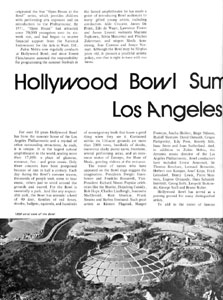
The Philharmonic was founded in 1919 by William Andrews Clark, Jr, art patron, bibliophile and amateur musician, who during the orchestra's first fifteen years gave $3 million for its support.
Clark brought Walter Henry Rothwell, then conductor of the St. Paul Symphony Orchestra, to lead the fledgling Philharmonic. Ninety-four musicians met for their first rehearsal Monday morning, October 13, 1919. Eleven days later, the Philharmonic played their first concert before a capacity audience of 2400 who were hearing the largest orchestra that had ever appeared in Los Angeles.

Rothwell remained as the orchestra's music director until his death in 1927. He had provided the Philharmonic with a thoroughly disciplined grounding.
His immediate successors were the Finnish conductor Georg Schneevoigt (1927-29), and the illustrious Arthur Rodzinski (1929-33), who had been engaged since 1926 as assistant conductor to Leopold Stokowski with the Philadelphia Orchestra.
The famed Hollywood Bowl concerts were begun in 1922, with Alfred Hertz, conductor of the San Francisco Symphony, directing the Philharmonic's first summer season.
In 1933, Otto Klemperer, who came directly from Switzerland, where he had been a refugee from the Nazis, succeeded Rodzinski. He remained with the orchestra until 1939 and during his tenure greatly enhanced the Philharmonic's growing reputation.
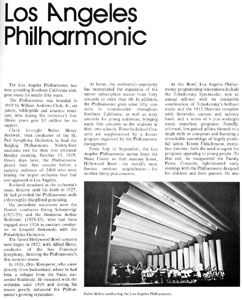
At home, the orchestra's popularity has necessitated the expansion of the winter subscription season from forty concerts to more than sixty. In addition, the Philharmonic gives some fifty concerts in communities throughout Southern California, as well as sixty concerts for young audiences, bringing many free concerts to the students in their own schools. These In-School Concerts are supplemented by a docent program organized by the Philharmonic management.
From July to September, the Los Angeles Philharmonic moves from the Music Center to their summer home, Hollywood Bowl - the world's most famous outdoor amphitheater - for another thirty-plus concerts.
At the Bowl, Los Angeles Philharmonic programming innovations include the Tchaikovsky Spectacular, now an annual sell-out with its irresistible combination of Tchaikovsky's brilliant music and the 1812 Overture complete with fireworks, cannon and military band; and a series of 6 pm-midnight music marathon programs: friendly, informal, low-priced affairs themed to a single style or composer and featuring a remarkable assemblage of largely youthful talent. Ernest Fleischmann, executive director, feels the need is urgent for programs appealing to young people. To this end, he inaugurated the Family Picnic Concerts, light-hearted early evenings with the Philharmonic designed for children and their parents. He also originated the free "Open House at the Bowl" series, which provides children with performing arts exposure and an introduction to the Philharmonic. By 1971, "Open House" had attracted some 70,000 youngsters over its six-week run, and had begun to receive financial support from the National Endowment for the Arts in Wash. D.C.
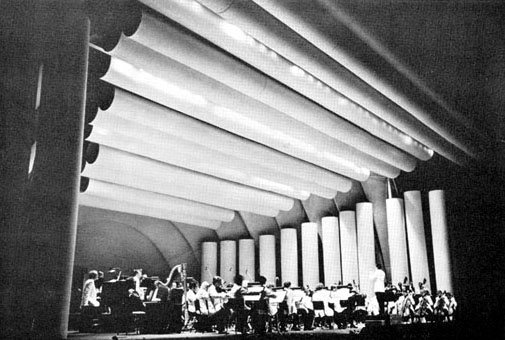
Zubin Mehta now regularly conducts at Hollywood Bowl, and since Ernest Fleischmann assumed the responsibility for programming the summer festivals in the famed amphitheatre he has made a point of introducing Bowl audiences to many gifted young artists, including conductors Aldo Ceccato, James De Preist, Edo de Waart, Lawrence Foster and James Levine; violinists Mayumi Fujikawa, Silvia Marcovici and Pinchas Zukerman; and singers Sheila Armstrong, Jose Carreras and Jessye Norman. Although the Bowl may be 50-plus years old, it pursues a youthful artistic policy, one that is right in tune with our times.
For over 50 years Hollywood Bowl has been the summer home of the Los Angeles Philharmonic and a myriad of other outstanding attractions. As such, it is unique. It is the largest natural amphitheatre in the world, seating more than 17,000: a place of glamour, romance, fun - and great music. Only three concerts have been postponed because of rain in half a century. Each day during the Bowl's summer season, thousands of people visit, some to hear music, others just to stroll around the grounds and marvel. For the Bowl is essentially a park. And like any respectable park, the Bowl has animals: a herd of 40 deer, families of red foxes, skunks, badgers, squirrels, and hundreds of nonmigratory birds that know a good thing when they see it. Contained within its 116-acre grounds are more than 2000 trees, hundreds of shrubs, numerous shady picnic spots, fountains, several performing areas, and an enormous statue of Euterpe, the Muse of Music, greeting visitors at the entrance.
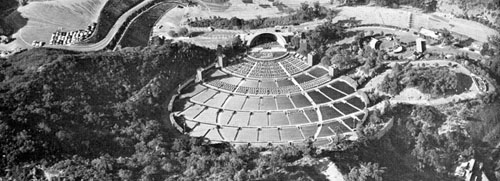
The roster of names who have appeared on the Bowl stage staggers the imagination. Presidents Dwight Eisenhower and Franklin Roosevelt, Vice-President Richard Nixon. Popular celebrities like the Beatles, Hopalong Cassidy, Bob Hope, Charles Lindbergh, Jeannette MacDonald, Ravi Shankar, Frank Sinatra and Barbra Streisand. Such great artists as Kirsten Flagstad, Margot Fonteyn, Jascha Heifetz, Birgit Nilsson, Rudolf Nureyev, David Oistrakh, Gregor Piatigorsky, Lily Pons, Beverly Sills, Isaac Stern and Joan Sutherland. And, in addition to Zubin Mehta, the dynamic music director of the Los Angeles Philharmonic, Bowl conductors have included Ernest Answermet, Sir Thomas Beecham, Leonard Bernstein, Herbert von Karajan, Josef Krips, Erich Leinsdorf, Henry Lewis, Pierre Monteux, Eugene Ormandy, Hans Schmidt-Issertedt, Georg Solti, Leopold Stokowski, George Szell and Bruno Walter.
Hollywood Bowl has served as a proving ground for many distinguished artists.
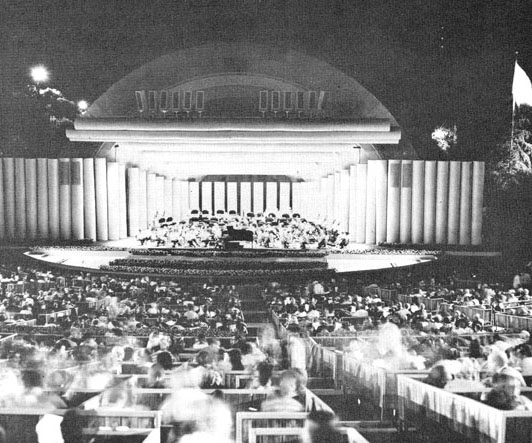
To add to the roster of famous names outside the field of music are motion picture and TV personalities who also performed at the Bowl. For example, Charlie Chan gumshoed his way around the Bowl in one of his matinée whodunits; Frank Sinatra and Gene Kelly danced and romanced at the Bowl in Anchors Aweigh; and dozens of other films like A Star is Born and Hollywood Hotel, and even a yodeling western, Horse Opera, have carried the image of the Bowl around the world.
Among others, TV's Mannix and The FBI have both filmed recent episodes inside the Bowl. And Ed Sullivan has originated his Sunday night variety show from the Bowl stage.
The Bowl's international reputation does not come lightly. Countless motion picture and television shows have been filmed there. During the mid-fifties the historic Russian cultural exchanges featuring the Bolshoi Ballet took place. The annual Easter Sunrise Service, featuring a "living cross" formed by a children's chorus, regularly attracts capacity audiences from throughout the Western United States. Dozens of record albums produced at the Bowl have helped make Hollywood Bowl a household word around the globe.
|
PH on stage | PH on record | PH in print | BtP features | What's new | Interact with BtP | For sale | Site search | Home |